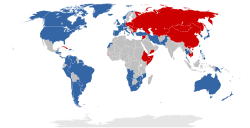First World

| 0.950 and over 0.900–0.949 0.850–0.899 0.800–0.849 0.750–0.799 0.700–0.749 | 0.650–0.699 0.600–0.649 0.550–0.599 0.500–0.549 0.450–0.499 0.400–0.449 | 0.350–0.399 0.300–0.349 under 0.300 N/A |
The terms First World, Second World, and Third World were used to divide nations into three broad categories. The three terms did not arise simultaneously. After World War II, people began to speak of the NATO and Warsaw Pact countries as two major blocs, often using such terms as the "Western Bloc" and the "Eastern Bloc". The two "worlds" were not numbered. It was eventually pointed out that there were a great many countries that fit into neither category, and in 1952 French demographer Alfred Sauvy coined the term "Third World" to describe this latter group; retroactively, the first two groups came to be known as the "First World" and "Second World".
History

Some countries did not fit into these partitions, including Switzerland, Sweden, and the Republic of Ireland, who chose to be neutral. Finland was under the Soviet Union's sphere of influence but was not communist, nor was it a member of the Warsaw Pact. Yugoslavia adopted a policy of neutrality, and was a founding member of the Non-Aligned Movement. Austria was under the United States' sphere of influence, but in 1955 the country became a fully independent republic under the condition that it remain neutral. Turkey and Greece both joined NATO in 1952, but are not predominantly in Western Europe. Spain did not join NATO until 1982, towards the end of the Cold War and after the death of the authoritarian dictator Francisco Franco.
As many developing countries have industrialized, the term Fourth World has been coined to refer to countries that remain predominantly agricultural or nomadic and lack industrial infrastructure. However, such coinage can create confusion because Fourth World is used by scholars to refer to stateless nations (such as indigenous nations in the Americas). Countries that were previously considered developing countries but now have a more developed economy are grouped under the term Newly-industrialized countries or NIC.
High income economies
While there is no precise definition of the first world, the World Bank does categorize countries by income, as high, upper-middle, lower-middle, and low income. High-income countries have a Gross National Income per capita of US$11,906[1] or more. According to the World Bank, the following 67 countries and territories were categorized as high-income economies as of 2008:[2]
High Income Countries not classified by World Bank:
IMF advanced economy list

According to the International Monetary Fund, the following 34 countries and territories are classified as "advanced economies:"[3]
 Australia
Australia Austria
Austria Belgium
Belgium Canada
Canada Cyprus
Cyprus Czech Republic
Czech Republic Denmark
Denmark Finland
Finland France
France Germany
Germany Greece
Greece Hong Kong
Hong Kong Iceland
Iceland Ireland
Ireland Israel
Israel Italy
Italy Japan
Japan Luxembourg
Luxembourg Malta
Malta Netherlands
Netherlands New Zealand
New Zealand Norway
Norway Portugal
Portugal San Marino[4]
San Marino[4] Singapore
Singapore Slovakia
Slovakia Slovenia
Slovenia South Korea
South Korea Spain
Spain Sweden
Sweden Switzerland
Switzerland Taiwan
Taiwan United Kingdom
United Kingdom United States
United States
References
- ^ "World Bank - Country Classification". Accessed on July 11, 2009.
- ^ World Bank - Country Groups. Accessed on July 11, 2009.
- ^ IMF Advanced Economies List. World Economic Outlook, Database—WEO Groups and Aggregates Information, October 2009.
- ^ World Economic Outlook, International Monetary Fund, October 2009, second paragraph, line 9-10.
